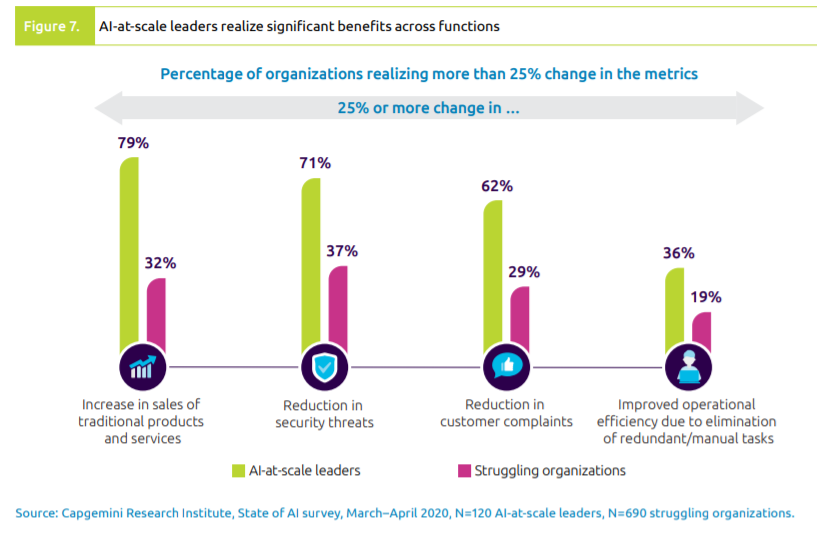How organizations are using data and AI to bring resilience and innovation to their operations
A few months ago, countries closed their borders, economies ground to a near standstill, employees became remote workers overnight, and everything we knew about doing business changed. Even today, we hear about “the new normal”, “the great reset”, and organizations are still required to demonstrate high agility to adapt in sudden changes in their market and region.
For many organizations, global crises have historically represented a watershed moment. Those that adapt and pivot are able to turn adversity into advantage, whereas those that don’t, risk failure. In this sense, COVID-19 is no different – accelerating several major business trends that were well underway before the outbreak began while forcing others to become obsolete.
One of these trends is the implementation of Artificial Intelligence (AI) to deliver operational efficiencies and support business model innovation and revenue generation while increasing our understanding of customers and markets. Investments are pouring into AI startups across various industries. According to the National Venture Capital Association, in 2019 AI-related firms in the United States had raised over $18.5 billion.
As organizations begin to emerge from crisis mode into rebuilding and reimagining businesses, there is a strong argument in place to prioritize data and AI initiatives – because, when scaled, research shows that they are highly valuable to organizations.
Let’s look at the data.
Benefits to business

According to our report, which explores how to unlock the potential of AI at scale, almost four in five “AI-at-scale leaders” – enterprises that use AI across multiple teams and locations – saw more than a 25% increase in sales of traditional products and services since 2017.
For 62% of AI-at-scale leaders, customer complaints fell by at least a quarter, and 71% of AI-at-scale leaders reduced security threats by the same amount. Given the importance of tackling customer pain points and security issues since the pandemic began, it’s likely that these AI leaders will have accelerated even further ahead in recent months.
Our findings also show that 53% of organizations have now moved beyond AI pilots and proofs of concept, a marked increase from 36% in 2017. 78% of AI-at-scale leaders continue to progress on their AI initiatives at the same pace as before COVID-19, while another 21% have increased the pace of their deployment.
Those organizations, where investment is progressing as before the pandemic, or even increasing, haven’t just succeeded in AI – they have seen it make a tangible difference to the top and bottom line.
But what characterizes the high-performing organizations that do successfully reach scale?
The ingredients for AI success

Drawing on the best practices employed by AI-at-scale leaders, as well as our hands-on experience with clients globally, it’s clear that organizations should prioritize data quality, data governance including ethics, and data platform foundations to build trust, and scale AI initiatives.
Predictions, forecasts, and decisions augmented by machine learning models are only as good as the information you feed them. Legacy systems that cannot cope with business needs, disparate data sources, and internal silos all hinder AI from creating the rich picture it needs.
Second, a large majority of organizations that are successful in wide-scale deployment also have one thing in common – strong Data & AI governance and change management, which is why leadership and talent are imperative. Not only is it important for existing talent to understand the value of AI but if digital transformation is treated like an add-on, that’s all it will ever become.
That’s why more than half of AI-at-scale leaders have an AI officer, or an equivalent – someone whose main priority is to push forward AI initiatives, rather than the role being foisted on an employee with overlapping responsibilities.
Connecting the tactical to the strategic
In recent years however, many organizations have rushed to create AI pilots, excited by its potential. Yet, in many instances, engagement with the business wasn’t strong enough, and returns were disappointing. One of the reasons is that their AI strategy wasn’t aligned to the organization’s most burning pain points or strategic business objectives.
It’s about more than just the technology – there is an even stronger need for connections between tactical and strategic business objectives. Leading organizations that have managed to do this by weaving AI into the fabric of their operations have not only built resilience into their processes and ways of working, they have gained the competitive edge they need to succeed.
It’s clear that implementing data and AI initiatives at scale has lived up to its promise of delivering real business benefits. Success comes down to adopting a data-driven culture, carefully focusing investments, and bringing data and AI programs into the organization’s wider digital transformation fold to truly unlock the full potential of AI at scale.
About the Author
 Anne-Laure Thieullent is Artificial Intelligence and Analytics Group Offer Leader at Capgemini, where she advises clients on how to get maximum business value from data & AI – making them AI-driven, data-centric, and innovative. Her passion is transforming clients into data & AI-powered organizations while cultivating values of trust, privacy, and fairness – the foundation on which technology, business transformation, and culture come together.
Anne-Laure Thieullent is Artificial Intelligence and Analytics Group Offer Leader at Capgemini, where she advises clients on how to get maximum business value from data & AI – making them AI-driven, data-centric, and innovative. Her passion is transforming clients into data & AI-powered organizations while cultivating values of trust, privacy, and fairness – the foundation on which technology, business transformation, and culture come together.



































